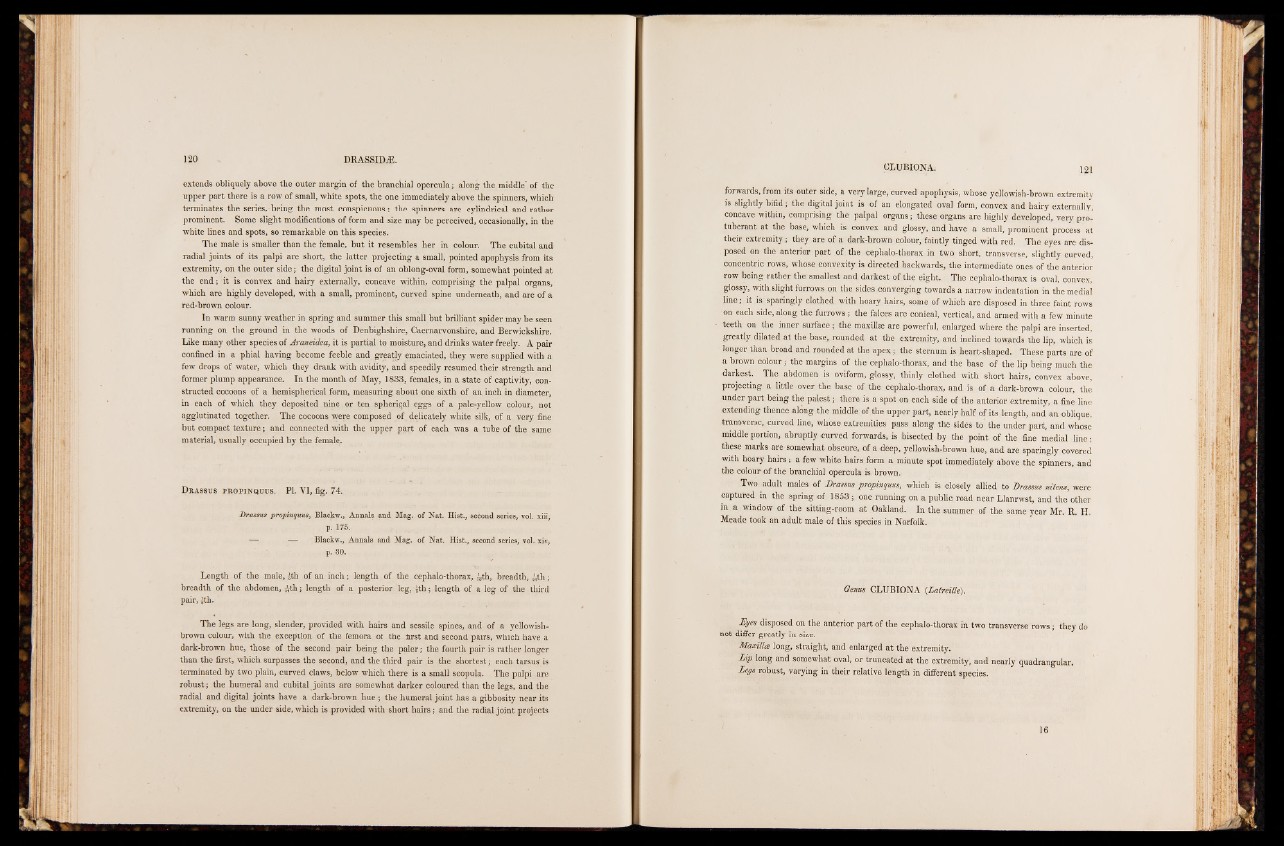
120 DRASSIDÆ.
extends obliquely above the outer margin of the branchial opercula; along the middle’ of the
upper part there is a row of small, white spots, the one immediately above the spinners, which
terminates the series, being the most conspicuous; the spinners are cylindrical and rather
prominent. Some slight modifications of form and size may be perceived, occasionally, in the
white lines and spots, so remarkable on this species.
The male is smaller than the female, but it resembles her in colour. The cubital and
radial joints of its palpi are short, the latter projecting a small, pointed apophysis from its
extremity, on the outer side; the digital joint is of an oblong-oval form, somewhat pointed at
the end; it is convex and hairy externally, concave within, comprising the palpal organs,
which are highly developed, with a small, prominent, curved spine underneath, and are of a
red-brown colour.
In warm sunny weather in spring and summer this small but brilliant spider may be seen
running on the ground in the woods of Denbighshire, Caernarvonshire, and Berwickshire.
Like many other species of Araneidea, it is partial to moisture, and drinks water freely. A pair
confined in a phial having become feeble and greatly emaciated, they were supplied with a
few drops of water, which they drank with avidity, and speedily resumed their strength and
former plump appearance. In the month of May, 1833, females, in a state of captivity, constructed
cocoons of a hemispherical form, measuring about one sixth of an. inch in diameter,
in each of which they deposited nine or ten spherical eggs of a pale-yellow colour, not
agglutinated together. The cocoons were composed of. delicately white silk, of a very fine
but compact texture; and connected with the upper part of each was a tube of the same
material, usually occupied by the female.
Drassus propinquus. PI. VI, fig. 74.
Drassus propinquus, Blackw., Annals and Mag. of Nat. Hist., second series, vol. xiii,
p. 175.
—: — Blackw., Annals and Mag. of Nat. Hist., second series, vol. xiv,
p. 30.
Length of the male, |th of an inch; length of the cephalo-thorax, ^th, breadth, 5'?th;
breadth of the abdomen, ^th; length of a posterior leg, «th; length of a leg of the third
pair, |th.
The legs are long, slender, provided with hairs and sessile spines, and of a yellowish-
brown colour, with the exception of the femora of the first and second pairs, which have a
dark-brown hue, those of the second pair being the paler; the fourth pair is rather longer
than the first, which surpasses the second, and the third pair is the shortest; each tarsus is
terminated by two plain, curved claws, below which there is a small scopula. The palpi are
robust; the humeral and cubitaljoints are somewhat darker coloured than the legs, and the
radial and digital joints have a dark-brown hue ; the humeral joint has a gibbosity near its
extremity, on the under side, which is provided with short hairs; and the radial joint projects
CLUBIONA. m
forwards, from its outer side, a very large, curved apophysis, whose yellowish-brown extremity
is slightly bifid ; the digital joint is of an elongated oval form, convex and hairy externally,
concave within, comprising the palpal organs; these organs are highly developed, very protuberant
at the base, which is convex and glossy, and have a small, prominent process at
their extremity ; they are of a dark-brown colour, faintly tinged with red. The eyes are dis-
. posed on the anterior part of the cephalo-thorax in two short, transverse, slightly curved,
concentric rows, whose convexity is directed backwards, the intermediate ones of the anterior
row being rather the smallest and darkest of the eight. The cephalo-thorax is ovalj'fpnvex,
glossy, with.slight furrows on the sides -converging towards a narrow indentation in the medial
line ; it ,is; sparingly clothed with hoary hairs, some of which are .disposed in three faint rows
on each side, along the furrows ; the fa lc f| are conical, vertical, and armed with a few minute
teeth on the inner surface ; the maxillæ are powerful, enlarged where the palpi are inserted,
greatly, dilated at the base, rounded at the extremity, and inclined towards the lip, which is
Jonger.thanbroad.and rounded at the apex; the sternum is heart-shaped. These parts are of
a brown colour ; the margins of the cephalo-thorax, and the base of the lip being much the
darkest. The abdomen is oviform, glossy, thinly'Sejothed with short hairs, convex above,
■projecting a little, over the base of the cephalo-thorax, and is of a dark-brown colour, the
-under part being the palest ; there is a spot on each side of the anterior extremity, a fine line
extending thence-along the. middle of .the upper part, nearly half of its length, and an oblique,
transverse, curved line, whose-extremities pass along the sides to the under part, and whose
middle portion, abruptly curved forwards, is bisected by the point of the fine medial line;
these marks are somewhat obscure, of a deep, yellowish-browu hue, and are sparingly covered
with hoary hairs ; a few white hairs form a minute spot immediately above the spinners, and
the colour of the branchial opercula is brown.
Two adult males of Drassus propinquus, which is closely allied to Drassus nitens, were
captured in the spring of 1853 ; one running on a public road near Llanrwst, and the other
in a window of the sitting-room at Oakland. In the summer of the same year Mr. R. H.
Meade took an adult male of this species in Norfolk.
Genus CLUBIONA (Latreille).
Eyes disposed on the anterior part of the cephalo-thorax in two transverse rows ; they do
not differ greatly in size.
Maxilla long, straight, and enlarged at the extremity.
L ip long and somewhat oval, or truncated 'at the extremity, and nearly quadrangular.
Legs robust, varying in their relative length in different species.